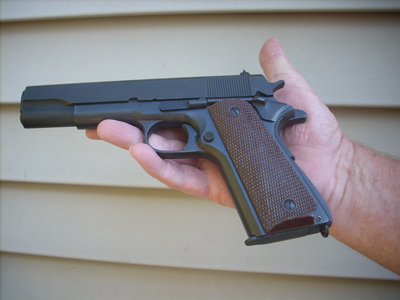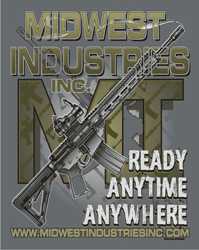The Greatest Pistol Of All Times Turns 100

With all the anniversaries, both good and bad, noted in 2011, one anniversary deserves special recognition by shooters as well as outdoorsmen in general. That is the 100-year anniversary of the M1911 .45 caliber semi-automatic pistol.
The 1911 is the greatest pistol of all time. It was used in every war our armed forces fought in during the 20th century. Now, in another century, it is still being used by soldiers, policemen, competition shooters and just about anybody that appreciates a good firearm.
After a century, the basic design of the M1911 is still the standard that semi-automatic pistols are measured by today. There are not too many things that have survived a hundred years and are still used today, but the M1911 .45 is going as strong as ever after a century of continuous use throughout the world.
The origins of the M1911 .45 came out of the Philippine-American War. Our military was fighting a jungle insurgency against the Moros native independence guerilla fighters. The Moros’s use of drugs that reduced the effects of pain, coupled with the high morale of insurgents, made them a formidable enemy. The standard military sidearm of the day was the .38 caliber Long Colt, which was quickly found to be completely inadequate for that kind of warfare. It had a poor stopping power against the drugged Moroses and could not stand up to the demands of usage in the harsh conditions of the jungle. Eventually the military substituted older .45 caliber single action Colt revolvers to use during fighting in the Philippines.
That experience from the Philippine-American War prompted the Army to start looking for a better pistol. They decided that they wanted a semi-automatic pistol in no less than a .45 caliber. John Browning, working with Colt, designed a semi-automatic pistol that Colt submitted to the Department of the Army for consideration. In 1906, the initial testing of semi-automatic handguns began with six manufactures including Colt. Of those six, Browning’s design for Colt and two others were found to be satisfactory for further testing. Only Savage and Colt submitted changes for further field testing that occurred from 1907 through 1910.
In one of the tests conducted at the end of 1910, a single Colt pistol fired over six thousand rounds in two days. When the pistol became too hot, it was simply submerged in water to cool it off. It was then reloaded and fired again.
The Colt pistol never experienced any problems, while the competitor from Savage experienced 37 malfunctions. The ruggedness of the Colt was a significant factor in the Army’s awarding the contract to manufacture its service pistol to Colt. The Army adopted the Colt pistol on March 29, 1911, which would eventually be officially designated as the Model 1911. Two years later the Navy and Marine Corps also adopted the M1911 as their official standard-issue side arm.
In addition to its ruggedness, it also was favored because of its lightweight and slim design. It weighed 2 pounds, 7 ounces unloaded and had a seven-round magazine. An additional round could be carried in the chamber. However, for safety reasons, most users only loaded the magazine, leaving the chamber empty, chambering a round by pulling the slide back when needed. Also, it was easy to disassemble, clean and reassemble. Its simplicity to maintain was an important factor with young soldiers under severe field conditions in far-flung parts of the world.
From there the legacy begins. It would see service in every conflict our country was engaged in from then on. When the United States entered World War I, it had only about 60,000 M1911s on hand. More were ordered. Corporal Alvin York used a M1911 to kill six German soldiers after he ran out of rifle ammunition, eventually being awarded the Medal of Honor for his heroism that day.
After World War I, minor modifications were made to the M1911which resulted in the new improved version being classified as the M1911A1. That weapon would be issued to millions more service members during World War II and for the next 60 years
During World War II, almost two million more M1911s would be manufactured by a number of different companies, including Remington Rand, who made typewriters and Singer, who normally manufactured sewing machines. Singer only made about 500 weapons, and today a Singer M1911 is prized by collectors.
Even the Nazis recognized the value of the M1911s. Before the war a Norwegian weapon factory had been licensed to produce M1911s. When the Nazis invaded and occupied Norway, they continued making the pistols that were issued to German forces. Also during the war, the Lend Lease program provided M1911s to both British and Russian armed forces.
In the wars and conflicts that came after World War II, the M1911s were the standard-issue for all of our armed forces. They went to Korea, Vietnam, and Desert Storm. During my last company command I had a group commander who, as a young cavalry lieutenant in Vietnam, got caught with his platoon in an ambush. By his own admission he never was a particularly good shot with the .45, but on that day he emptied his pistol and killed seven enemy soldiers. He was awarded the Silver Star for his actions that day, and, more importantly, survived Vietnam to eventually rise to the rank of Colonel by the time he retired from the Army.
Armies throughout the world have adopted the M1911 as their issue side arm that have included Spain, Greece, Ecuador, Argentina and the Philippines, to name just a few. Over 30-some armies have used the M1911 .45.
Throughout its distinguished history the M1911 .45 was adopted by many of our law enforcement agencies and became the weapon of choice for both the good guys and bad guys. Legend has it that bank robber Bonnie Parker of Bonnie and Clyde infamy died with a .45 in her lap. There is a story that makes the rounds of the Internet that a young reporter asked a police chief in Florida why his officers use a .45 and the police chief responds, “Because they don’t make a .46.”
The M1911 also made it into films and books. A poster for the movie “The Maltese Falcon” in 1941 showed Humphrey Bogart armed with two M1911s promoting the movie as “A story as explosive as his blazing automatics.” When Mickey Spillane began writing in the 1950s, he armed his detective Mike Hammer with a .45.
The M1911 is an amazingly accurate weapon system. Many pistol shooting teams use it today for competition shooting. Obviously, the reason they do so is because it is such a good gun.
The fact that the design of the M1911 is copied in every semi-automatic pistol manufactured today is a testament to the brilliant simplicity of Browning’s design. Although some firearms makers have tinkered with the original design, they have found it difficult to make more than just a few minor adjustments. Although the M1911 is most often associated with the .45 caliber, other calibers have been used with the 1911. I own a 9mm made by Star that looks exactly like the .45.
In the 1990s, our military was looking to replace the M1911 .45 ACP and eventually replaced it with a 9mm semi-automatic. There was a school of thought at that time that our issue side arm needed to be compatible with our European allies, and they all carried 9mm pistols. However, in Iraq and Afghanistan, soldiers had some of the same objections to the 9mm as the soldiers in the Philippine-American War a hundred years earlier had for their issue .38 caliber revolvers. Today the M1911 .45s are being reissued to American soldiers on a limited basis in those conflicts.
I have an ongoing love affair with the M1911 .45. I carried one as a military police officer for most of my 20-plus year Army career. I found the pistol to be accurate when soldiers are trained properly with it, and it’s a reliable weapon under the most demanding conditions. It was legendary for its knockdown power. One sergeant told me that no matter where you hit someone with a .45. it is going to take them down. Those were all the same reasons that our military adopted it as our official side arm and why so many law enforcement agencies and police forces still use it.
My father, as a Marine Sergeant in the South Pacific during World War II, was issued a .45 for awhile. He joked that when he went to the rear, he was always getting saluted since usually only officers carried pistols. Forty years later when I was deployed to Desert Storm, I carried a .45 when I arrived in Saudi Arabia.
The first company I commanded in the early 1980s was a military police training company that first provided basic combat training and then initial military police training. I would spend a lot of time on ranges and came to appreciate the lethal simplicity of the M1911 .45. Soldiers would adapt readily to qualifying with the M1911 and could easily take it apart and quickly clean it.
I was lucky. I never had to transition to the new 9mm. The last troop unit I was in still issued the .45. After that I worked with reserve and National Guard units until I retired in 1994, and they were still using the .45 at that time. They would eventually get the 9mm, but they would get it after the active duty units received them sometime after I retired.
Just before I retired from the Army I purchased a M1911A1 .45. It was an exact replica of the weapon I had carried for all those years I served in the Army. I consider it my first choice for a survival pistol for personal protection. I don’t think there is anything better on the market for its price. I suppose that I may be partial to that pistol after having carried it for so many years.
As the M1911 .45 and its many civilian descendants go into another century of use, it is worthwhile to know that it is just as good and effective as ever. All of our semi-automatic pistols that we have today owe a debt of gratitude to Mr. Browning and the simple but ever-so-effective design that he pioneered. It is still in use today and will be for many years to come.









